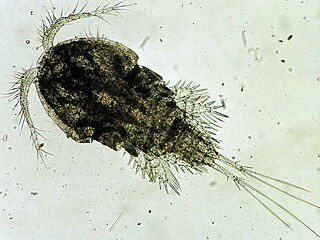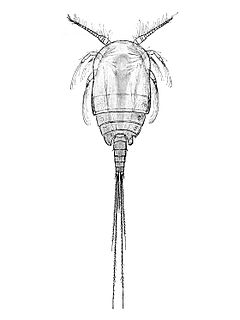Related Research Articles
Tantulocarida is a highly specialised group of parasitic crustaceans that consists of about 33 species, treated as a subclass of the class Hexanauplia. They are typically ectoparasites that infest copepods, isopods, tanaids, amphipods and ostracods.

The family Argulidae contains the carp lice or fish lice – a group of parasitic crustaceans of uncertain position within the Maxillopoda. Although they are thought to be primitive forms, they have no fossil record. The Argulidae are the only family in the order Arguloida, although a second family, the Dipteropeltidae, has been proposed.

The Cyclopoida are an order of small crustaceans from the subclass Copepoda. Like many other copepods, members of Cyclopoida are small, planktonic animals living both in the sea and in freshwater habitats. They are capable of rapid movement. Their larval development is metamorphic, and the embryos are carried in paired or single sacs attached to first abdominal somite.

Calanus is a genus of marine copepod in the family Calanidae. The genus was split in 1974, with some species being placed in a new genus, Neocalanus. The following species are recognised:
Hemiboeckella is a genus of crustacean in family Centropagidae. It contains the following species:
Idiodiaptomus gracilipes is a species of copepod in the family Diaptomidae. It is endemic to "a pool at Itapura", in São Paulo state, Brazil.
Paradiaptomus excellens is a species of copepod in the family Diaptomidae. It is endemic to South Africa.
Paradiaptomus simplex is a species of copepod in the family Diaptomidae. It is endemic to South Africa.
Paradiaptomus is a genus of crustacean in the family Diaptomidae. It includes the following species:
Ponticyclops is a genus of copepods in the family Cyclopidae.
Spelaeodiaptomus rouchi is a species of copepod in the family Diaptomidae. It is endemic to France.
Speleophria is a genus of marine copepods in the family Speleophriidae. It contains the following species:

Canthocamptidae is a family of copepods. Most of the 700 species are confined to fresh water, although there are also marine species. It contains the following genera:

Acartiidae is a family of calanoid copepods distinguishable by the rostral margin not being extended. They are epipelagic, planktonic animals, not being found below a depth of 500 metres (1,600 ft). There are over 100 described species distributed throughout the world's oceans, mainly in temperate areas.
Paradiaptomus africanus is a species of copepod in the family Diaptomidae. As an example occurrence, Lovenula africana is found within the Makgadikgadi Pans, a seasonal hypersaline wetland in Botswana.
Paralubbockia longipedia is a species of copepod, and the only member of the family Paralubbockiidae. The family is characterised by the ventral position of the fifth legs, the possession of a separate maxillary palp, and the form of the endopods of the legs and antennae. The closest relatives of Paralubbockia are the family Oncaeidae. Initially placed among the Poecilostomatoida, Paralubbockia is now considered part of the Cyclopoida.
Centropagidae is a family of copepods. Its members are particularly known as plankton in coastal waters and in fresh water in Australia and southern South America. They are also found on subantarctic islands and in lakes in Antarctica.

Tegastidae is a family of copepods, which are characterised by having laterally compressed bodies, a claw-like mandible in the nauplius stage, and by a modified male genital complex. 85 species have been described in 6 genera. Two species of Smacigastes are found at hydrothermal vents, while the remaining species are found in shallow water, associated with algae, bryozoans and cnidarians, such as corals.

Misophrioida is an order of copepods, containing the following families:

Temora is a genus of copepods in the family Temoridae. The World Register of Marine Species lists the following species:
References
- ↑ T. Chad Walter. T. Chad Walter & Geoff Boxshall (ed.). "Gladioferens Henry, 1919". World Copepoda database. World Register of Marine Species . Retrieved November 14, 2010.